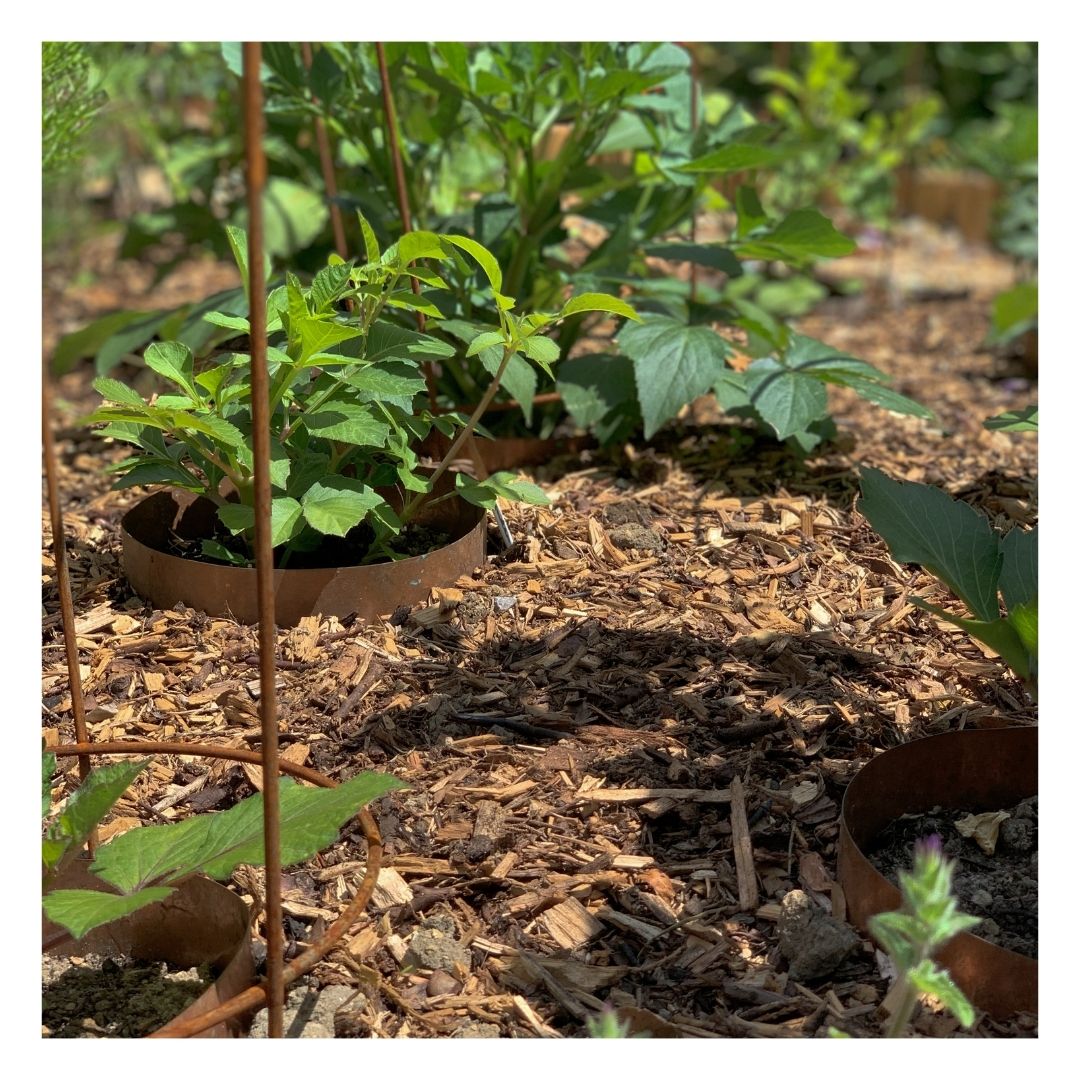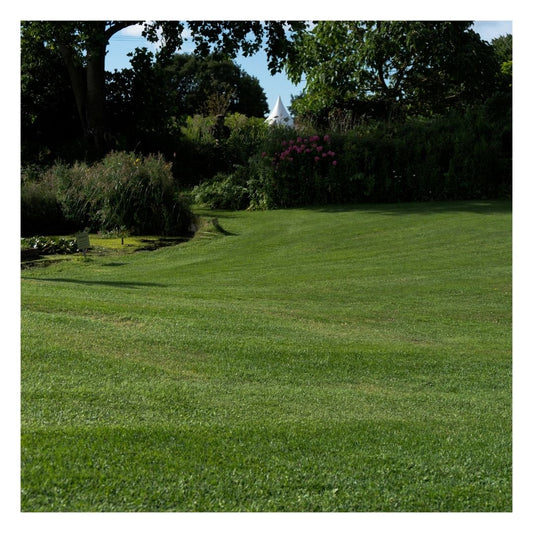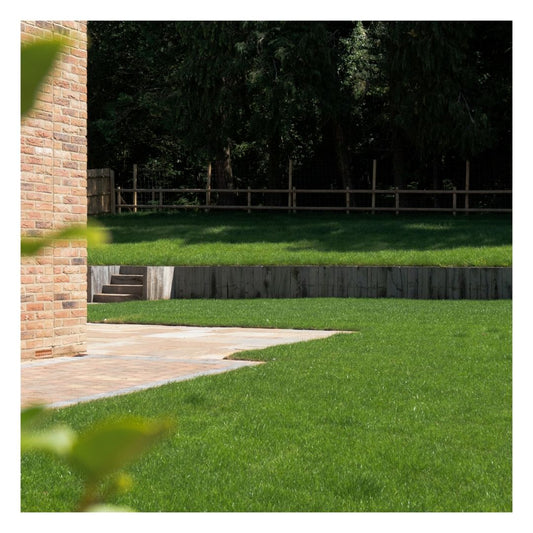How to Fix a Waterlogged Lawn
You might not be surprised but there is no quick fix for a waterlogged lawn. It is a a bit of a waiting game and then some forward planning and maintenance to try to fix things for the next rainy season. Most importantly you should avoid walking on the grass while it’s waterlogged as this will make things worse. Once the water has subsided you can assess the damage and consider your next steps factoring in the following:
1. Aeration
Aerating the lawn will help to improve drainage and will add air into the soil which will improve the conditions for the grass roots to live in. You can aerate the lawn by either spiking the lawn with a garden fork or aerator shoes, or by using a hollow tine aerator. The best tool will depend on the severity of your lawn’s waterlogging, and the type of soil you are dealing with. A hollow tine aerator removes cylinders of soil 10-15cm deep, which can then be filled with horticultural sharp sand which will help to keep the soil loose and draw out the moisture, this will help the lawn to recover more quickly. Regular aeration is essential throughout the spring and summer months to help minimise the compaction of the soil, which will in turn help to minimise waterlogging in the autumn and winter.
2. Moss Killer & Fertiliser
Wet soil and dead patches of grass allow moss to grow. This should be treated with a moss killer to prevent it from taking over allowing the lawn to thrive. Fertiliser should be used on the lawn during the spring to help the grass recover from a wet winter. Using a fertiliser will also help the grass root system to develop into a stronger network which should help the grass to withstand future waterlogging.
3. Dig A French Drain
If the waterlogging is severe consider having a French drain installed, although this will likely involve professionals, heavy machinery and some upheaval to the garden. Installing a french drain (or any drainage) will help surface water to run away from the problem area. You will need shingle for your French drain and you may choose to have new top soil and turf laid following the addition of a French drain to further improve the results.
4. Choose Permeable Paths & Patios
Choose pathways and patio surfaces which allow water to easily soak in, this will help to prevent the water running off onto the grass making the waterlogging worse. Shingle or bark pathways are probably the most permeable.
5. Dig A Ditch
This is not a suitable suggestion for every garden but digging a ditch at the lowest point would allow water to run away and sit somewhere it won’t do any damage. Depending on the size of your garden you could even make a feature out of it and turn it into a pond!
6. Plant A Bog Garden
Not for everyone, this idea is a little less about the actual lawn and more about the surrounding area. However, creating a ‘bog’ garden by choosing plants which thrive in waterlogged areas and will help to soak up some of the excess water. A bog garden can also create an slightly tropical look and will create a nice habitat for some garden insects.
7. Over-Seeding
Seed the lawn in the spring and summer, both on bare patches and where the grass is thick. Not only will this help to keep moss at bay, it will also help to create a thicker lawn with a more complex root structure which will be able to absorb more water during the next rainy season. Be sure to choose a grass seed which has a resilience to damp roots as it will be better suited to the conditions.
8. Collect Rainwater
Use a water butt by sheds or roofs with no drain for the water to run into. Collecting the rainwater in these key places will stop excess water from pouring onto the grass. Water from water butts can then be used to water plants or even wash cars. If the water level gets too high, drain it out and pour it down the drain to prevent it from overflowing and soaking the grass.
9. Dig It All Up And Start Again!
Not an ideal scenario due to the cost and work involved. However, digging up and removing your existing soil (possibly with a high amount of clay in it), putting fresh soil in its place, and even incorporating a French drain (or two) will make a substantial difference to your waterlogging problems. You will want to have new turf laid on your new soil and follow some of the steps above to ensure that your new garden is set up to withstand future heavy rains. Be sure to view our landscaping products.
What Is A Waterlogged Lawn?
Waterlogged lawns occur when clay-like, dense or compacted soil is subjected to periods of heavy rain. The rainwater sits on the surface of the lawn and fails to drain away through the soil, leaving the lawn underwater. Healthy soil is full of air, which allows grass roots to breathe, but when water saturates the soil, the air in the soil travels to the surface and escapes. This is a problem for grass roots as they need oxygen to live. Although grass is quite hardy and could survive a few days without oxygen, it would eventually begin to turn yellow and die.
How to Spot a Waterlogged Lawn
This might sound obvious – if a lawn is either partly or fully covered by water it’s safe to say it’s waterlogged. However, you might come across a lawn which isn’t currently saturated, so it is not immediately obvious that the lawn is prone to waterlogging. A waterlogged lawn is squelchy to walk on and it may have a lot of moss growth. Examine the blades of grass for signs of yellowing which indicates the lawn is, or has recently been, starved of oxygen.
Shop Eco Turf
-
Eco Turf: Medallion Premium
Regular price From £238.50 GBPRegular priceUnit price per -
Eco Turf: Hallstone
Regular price From £208.50 GBPRegular priceUnit price per -
Eco Organic Compost: Lawn Dressing
Regular price £130.95 GBPRegular priceUnit price per -
 Sold out
Sold outEco Turf & Lawn Seeding Soil
Regular price £126.95 GBPRegular priceUnit price per













